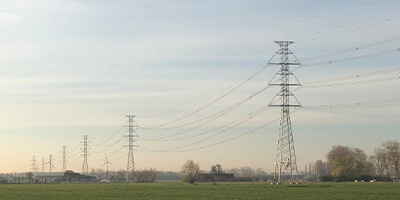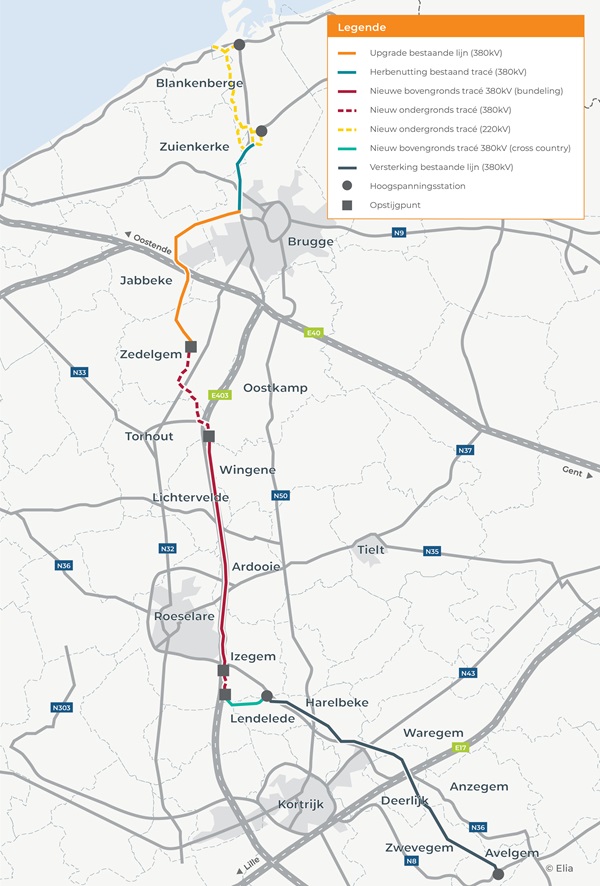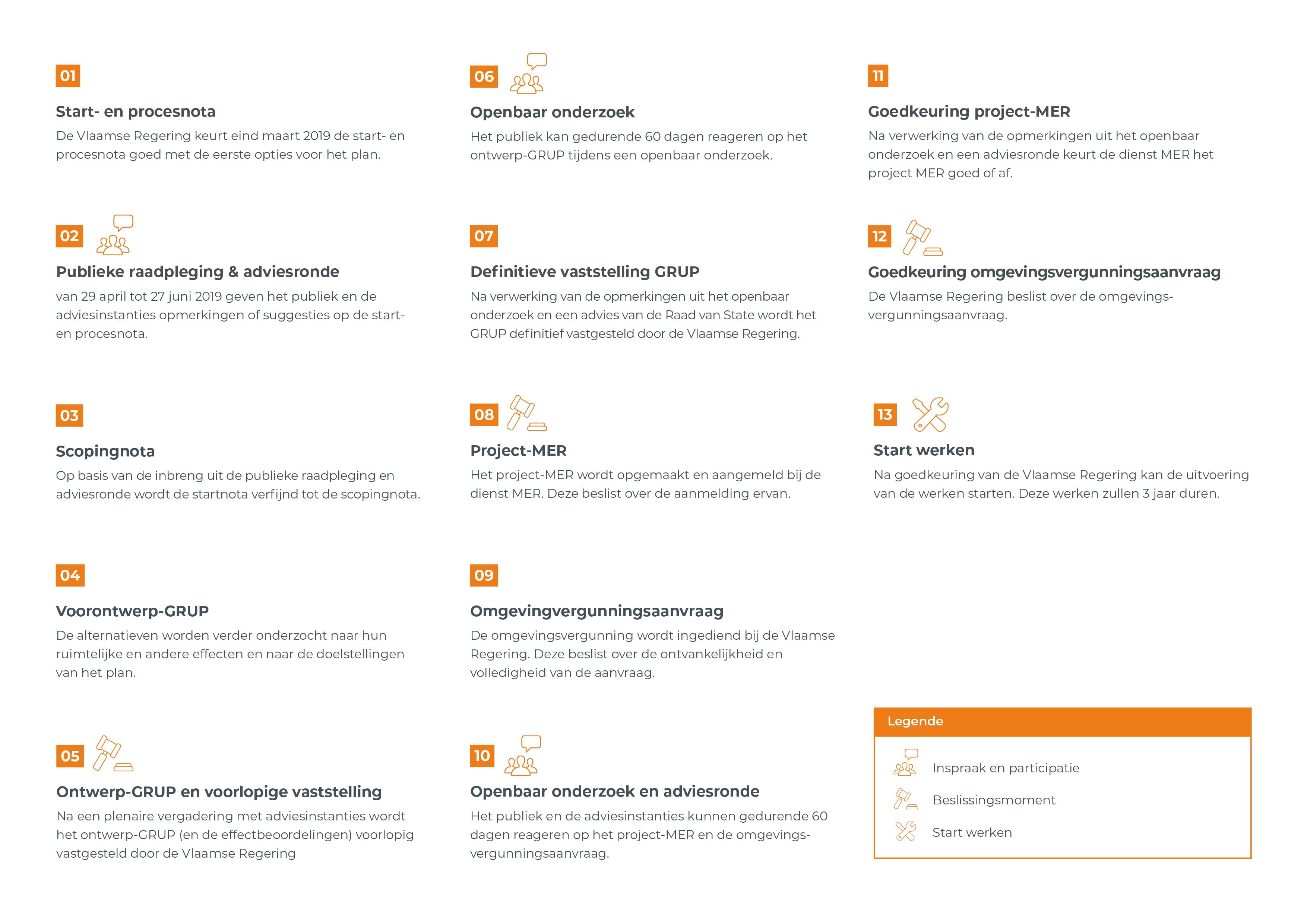Ventilus
Providing for a strong, future-oriented and reliable grid

Shifting to sustainable energy
Renewable energy will be increasingly in the spotlight in the coming years. A new wind zone off the coast will further boost wind generation capacity in the North Sea to close to 6 GW by 2030. New connections with other countries (interconnectors) will also increase the exchange of energy between countries. All that extra green energy is needed due, for example, to the rise of electric cars and the electrification of businesses specifically and society in general. Ventilus brings this energy to families and businesses. It also provides for a more robust and reliable grid in both West Flanders and Belgium as a whole.
-
 In the interest of society
In the interest of societyThrough the Ventilus project, Elia is providing for a strong, future-oriented and reliable grid. The project has several aims:
- Support the energy transition
The energy transition is being irreversibly implemented as a result of political decisions taken at national, European and international level. In order to cut greenhouse gas emissions, we are switching from fossil fuels to renewable energy. As such, over the next few years more and more green electricity will be generated in the Belgian part of the North Sea and in West Flanders. Ventilus aims to help support this shift by bringing renewable energy to households and businesses, thus contributing to the climate goals.
- Enhance wind generation in the North Sea
In the future, the Belgian part of the North Sea will become the access point for renewable energy. The expansion of wind turbine capacity off the Belgian coast means that more green energy will be generated. New connections with other countries (interconnectors) will also increase the exchange of renewable energy between countries. This is key to maintaining a constant balance between electricity supply and demand.
- Enable additional energy generation in West Flanders
West Flanders is catching up significantly in terms of onshore (wind) energy generation. This is also necessary to permanently meet rising demand for energy, including from businesses. Once the government has issued the associated licences, these generation facilities must be connected to the grid. To accommodate these facilities, the grid consequently needs to be shored up.
- Ensure a stronger and future-oriented grid in West Flanders
The high-voltage grid in West Flanders is not currently strong enough to transmit the huge increase in volumes of renewable energy. The south of West Flanders, for example, has a high level of economic activity, resulting in increasing demand for electricity in the area. This electricity is mainly supplied by the connection from Avelgem. A new supply line and fully-fledged high-voltage substation in Izegem are key to ensuring continued energy supplies and entrenching economic activity in the region.
- Boost grid reliability
To prepare the high-voltage grid for the future, Ventilus is looping in the existing Stevin high-voltage connection. This creates multiple routes through which electricity can be transmitted, meaning that the high-voltage grid will be well meshed. Such meshing boosts the reliability of the grid in the event of incidents or maintenance and allows more energy to be transported with less infrastructure. Meshing also means that Ventilus must be realised on alternating current to allow electricity to flow optimally in both directions along the 380-kV connections. As such, Ventilus can also be easily integrated into the European 380-kV AC network.
-
What is Ventilus?

The Ventilus project is a high-voltage connection spanning 82 kilometres between Zeebrugge and Avelgem. The project comprises both new overhead lines, the reuse of existing overhead lines, underground cable connections and new or expanded electrical facilities (high-voltage substations, terminal towers and a converter station). (See 'The route' for the overview from north to south, see 'Interactive map' for an interactive view of the route).
- New high-voltage connections: the Ventilus project consists of both overhead lines and underground cable connections.
- Above ground: wherever possible, existing 150- or 380-kV overhead lines will be reused. A new, approximately 17-km-long overhead line will also be erected along the E403.
- Underground: part of the route will be laid underground, namely from Zeebrugge to Bruges (approx. 10 kilometres at 220 kV), around Torhout and around Izegem (at 380 kV, approx. 10 kilometres underground).
- Electrical facilities: in order to efficiently transmit electricity from offshore to the mainland, the Ventilus project also involves the construction and/or extension of various electrical facilities. Several high-voltage substations will be expanded, for instance. A high-voltage substation is an important junction when it comes to transmitting electricity. Where an overhead line transitions to an underground cable (or vice versa), there will be a terminal tower. A new converter station will also be built in Bruges to convert the direct current from Princess Elisabeth Island into alternating current to integrate the electricity into the Belgian and European electricity network.
- Landing and connection of Princess Elisabeth Island:Princess Elisabeth Island, the world's first energy island, will be located some 45 kilometres off the Belgian coast and will serve as an electricity hub. It will bundle the cables of the wind farms of Belgium's second offshore wind zone and the cables of the connections with other countries (interconnectors). It will then efficiently bring the electricity in these bundled cables ashore. The subsea connections land on Zeebrugge/Blankenberge beach and connect the energy island to the grid on land via land cables. Electricity is transmitted via underground cables (six cables at 220 kV) to Gezelle high-voltage substation (Bruges).
- Several underground 150-kV connections: as part of the Ventilus project, some 150-kV overhead lines are being reused to upgrade them to 380 kV. The 380-kV network is considered the motorway of our grid, providing for smooth transmission and exchange with neighbouring countries. As such, its purpose differs to that of 150-kV connections, which are instead seen as local roads or branches. As such, some 150-kV connections will be laid underground (e.g. Bruges Blauwe Toren-Waggelwater, Bruges-Ostend Slijkens).
- New high-voltage connections: the Ventilus project consists of both overhead lines and underground cable connections.
-
 The route
The routeThe map below shows the final route of the Ventilus high-voltage line, as approved by the Flemish Government in the Regional Land Use Plan.
The Flemish Government's choice of route takes into account the principles of good spatial planning:
- Shoring up existing lines
- Reusing existing routes
- Making use of existing linear structures such as roads/rivers or existing routes
- If the above options are not possible, a new route will be explored.
- The total length of the above-ground network should not be extended (stand-still principle).
- Construction of underground connections between Blankenberge/Zeebrugge beach and Bruges (Gezelle and Herdersbrug)
There will be several underground cable connections between Blankenberge/Zeebrugge beach and Bruges. The 220-kV AC connections and a 525-kV DC connection depart from Princess Elisabeth Island. These underground cables come ashore in Blankenberge/Zeebrugge. There is also another 380-kV connection from Stevin substation in Zeebrugge.>The 220- and 380-kV connections will be connected to Gezelle high-voltage substation (Bruges), where the existing high-voltage substation will be expanded. The DC connection goes to the new converter station next to Herdersbrug power plant.
- Reuse and upgrade of the existing Brugge Blauwe Toren - Brugge Waggelwater line
The existing overhead 150-kV line between the Brugge Blauwe Toren and Brugge Waggelwater high-voltage substations will be brought underground and the existing line will be reused to build an overhead 380-kV connection over a distance of around five kilometres. The route will also be optimised to a limited extent: the 380-kV line will pass closer to the N31 (dual carriageway) near Blauwe Toren than the current 150-kV line.
- Reuse and upgrade of the existing Brugge Waggelwater - Zedelgem line
Elia is upgrading the existing 150-kV high-voltage line (over a distance of 14 kilometres) between Brugge Waggelwater and Zedelgem to 380 kV. To this end, Elia is adding two 380-kV three-phase transmission lines to the existing pylons. In Zedelgem, a terminal tower will be erected around Brugsestraat and Strubbenslag. This forms the transition between the overhead and underground high-voltage line, and primarily consists of outdoor facilities surrounded by a green buffer.
- Construction of an underground connection (380 kV) between Zedelgem and Baliebrugge
Elia is laying an underground, eight-km-long connection (380 kV) between Zedelgem and Baliebrugge (Oostkamp).
- Construction of an overhead high-voltage line (380 kV) between Baliebrugge and Izegem
Elia is planning a new terminal tower in Baliebrugge (Oostkamp) around Torhoutsestraat. This mainly consists of outdoor facilities surrounded by a green buffer. Elia will also construct a new 17-km-long overhead high-voltage line (380 kV) from this terminal tower towards the De Mol (Izegem-Noord) terminal tower. This new high-voltage line will be bundled with the E403.
- Construction of an underground connection (380 kV) between De Mol and Bosmolens
Elia is planning a new terminal tower in De Mol (Izegem-Noord) off the N36 (slip-road 6 Roeselare-Rumbeke). Elia is also building a new terminal tower in Bosmolens (Izegem-Zuid) near the motorway car park on the E403/A17. These terminal towers mainly consist of outdoor facilities surrounded by a green buffer. Between the two terminal towers, Elia is building a new 380-kV underground connection spanning two kilometres.
- Construction of an overhead cross-country high-voltage line (380 kV) between Bosmolens and Izegem
Elia is laying a new overhead 380-kV high-voltage line (over a distance of 3.5 kilometres) between the terminal tower in Bosmolens (Izegem-Zuid) and Izegem high-voltage substation in Lendelede. This stretch of the route is a cross-country line, meaning that it does not run parallel to other infrastructure.
- Strengthening of the existing high-voltage line (380 kV) between the Izegem and Avelgem high-voltage substations
Elia is shoring up the high-voltage line (380 kV) over a distance of 22.5 kilometres between the Izegem and Avelgem high-voltage substations using High Temperature Low Sag (HTLS) conductors. This new type of conductor can transport more electricity than those currently in use.
-
 TechnologyA range of technologies can be used when it comes to building and operating a high-voltage connection. The technology chosen must be reliable and align with the needs of the grid. A lot of work went into choosing the technology for Ventilus. A technology study was conducted in preparation for the launch notice in 2019. A group of six independent experts then double-checked this study in 2020. At the request of citizens' platforms, this was supplemented by an opinion from the HVDC Centre in Scotland. In 2021, Flemish Minister Zuhal Demir appointed Guy Vloebergh as the intendant. Guy and his team also researched the most suitable technology and independently engaged with all stakeholders. Finally, German professor Dirk Westermann was also involved in discussions regarding the choice of technology for the project in 2022. All studies came to the same conclusion: on a technical level, an overhead AC line, with a partially underground section spanning 8 to 12 kilometres, is the best choice for Ventilus. The study reports (in Dutch) can be found atomgeving.vlaanderen.be.
TechnologyA range of technologies can be used when it comes to building and operating a high-voltage connection. The technology chosen must be reliable and align with the needs of the grid. A lot of work went into choosing the technology for Ventilus. A technology study was conducted in preparation for the launch notice in 2019. A group of six independent experts then double-checked this study in 2020. At the request of citizens' platforms, this was supplemented by an opinion from the HVDC Centre in Scotland. In 2021, Flemish Minister Zuhal Demir appointed Guy Vloebergh as the intendant. Guy and his team also researched the most suitable technology and independently engaged with all stakeholders. Finally, German professor Dirk Westermann was also involved in discussions regarding the choice of technology for the project in 2022. All studies came to the same conclusion: on a technical level, an overhead AC line, with a partially underground section spanning 8 to 12 kilometres, is the best choice for Ventilus. The study reports (in Dutch) can be found atomgeving.vlaanderen.be. -
Accompanying policy

- Electromagnetic fields: high-voltage connections through which current flows generate both electric and magnetic fields. Only very strong electric fields can impact humans; such strong fields are not generated by the high-voltage lines in Flanders. Electricity transmission also generates magnetic fields. The strength of these fields depends on the amount of current transported through the line. The greater the current, the stronger the magnetic fields. Distance is also important: the further away from the conductors (electric wires), the weaker the magnetic fields. For more information (in Dutch) on electric and magnetic fields, click here.
- Compensation policy: as a high-voltage system operator, Elia strives to prevent its infrastructure activities from having any impact. If prevention is not possible, then we try to minimise that impact. Since mitigation is sometimes not possible, Elia has developed a compensation policy. That policy covers the loss of value suffered by homes and building plots due to the visual impact of our electrical facilities. More information on the compensation policy can be found on the Measures and compensation page
- Expansion of landscape integration and community fund: to limit the visual impact on the environment and local residents, Elia takes measures in the surrounding landscape. These measures often consist of implanting defensive hedges, rows of trees and/or shrub borders. The community fund is also available to the local community affected by Elia's infrastructure works. Elia contributes financially to this fund, thus helping to improve residents' physical environment. This fund is managed by Be Planet.
- Early undergrounding of some overhead lines in West Flanders: as an accompanying policy, Elia will demolish and underground some overhead lines in West Flanders ahead of schedule. This concerns 70- and 150-kV lines, which are considered provincial roads, whereas Ventilus, at 380 kV, is seen as a real motorway of our grid. This will impact 86 kilometres of 70-kV lines and 33 kilometres of 150-kV overhead lines in West Flanders. Some of these will be demolished and laid underground before construction of Ventilus begins, while others will be dealt with after Ventilus is complete. Specifically, this affects the following overhead lines: Moeskroen-Zwevegem, Koksijde-Noordschote between Noordschote and Wulpen, Noordschote-Ieper, Ieper-Bas-Warneton, Bas-Warneton-Wevelgem, St-Baafs-Vijve-Desselgem, Deinze-St-Baafs-Vijve, Pittem-Beveren between Muizelaar and Beveren, Beveren-Rumbeke-Izegem, and the Izegem-Pittem line.
-
 Schedule
ScheduleVentilus follows an integrated planning process (see below). The Regional Land Use Plan (GRUP) has been definitively adopted. Elia is currently working on the environmental impact assessment and the environmental permit application. Given the scale of the project, this will take several months.
More information (in Dutch) on the procedure can be found atomgeving.vlaanderen.be and in the diagram below.
-
 Interactive map
Interactive mapDiscover here the overview of the provisional locations of the high-voltage pylons along the Ventilus route
Discover here the interactive map below with a visual representation of the Ventilus route
-
 Documents
DocumentsYou can consult the Ventilus process documents (in Dutch) at omgeving.vlaanderen.be
News

30 October 2025
Public Inquiry from November 8 to December 7
From November 8 to December 7, a public inquiry will be held regarding the Ventilus project, as part of the environmental permit applications.

14 March 2025
The Ventilus project is entering a new phase
Following the scoping memorandum (guidelines for the planning process), the preliminary draft Regional Land Use Plan (GRUP) and the final adoption of the GRUP (phases when the Flemish authorities took the lead on this project), Elia is now picking up the reins. In the next phase, feedback on the project environmental impact assessment (EIA) will be requested.




